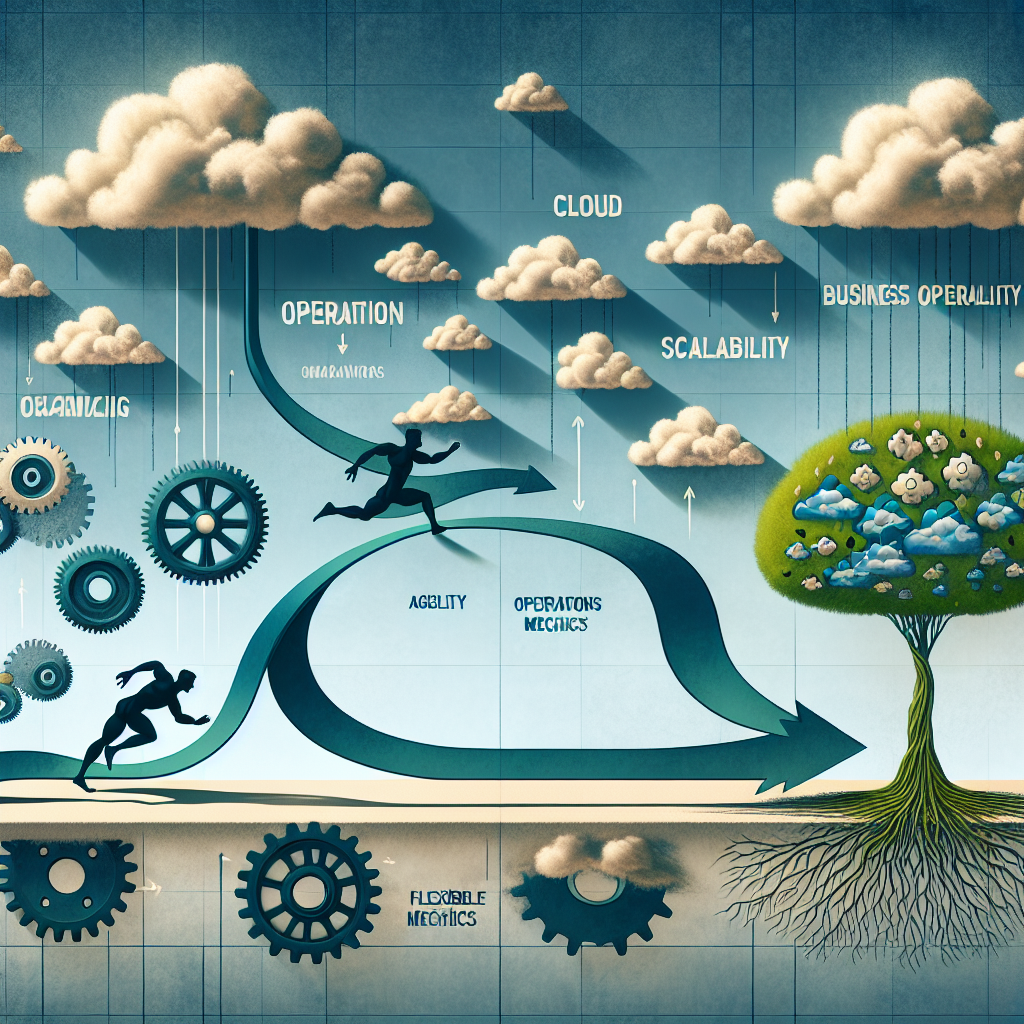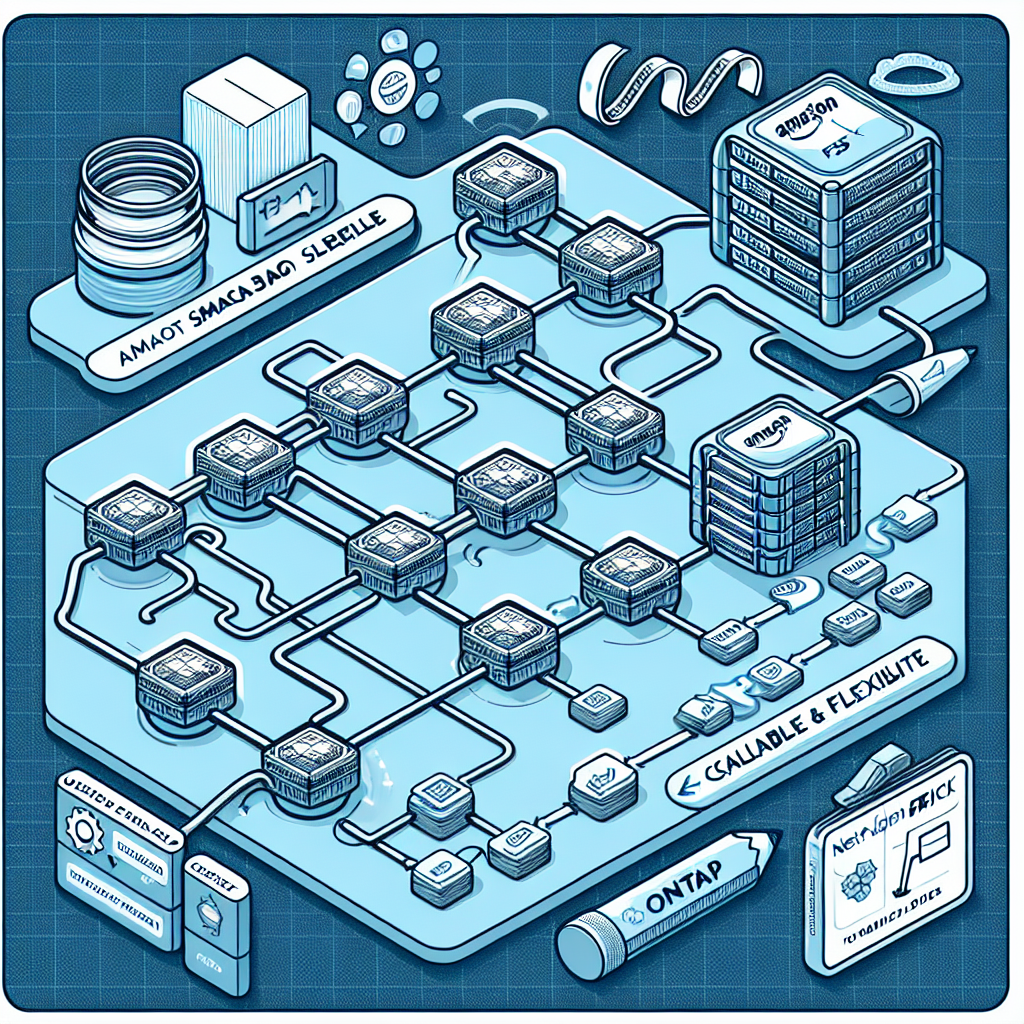Your cart is currently empty!
Tag: Scalability

The Benefits of CloudOps for Improving Efficiency and Scalability
CloudOps, short for Cloud Operations, is a set of practices and tools that help organizations manage and optimize their cloud infrastructure. By implementing CloudOps, businesses can improve efficiency and scalability, leading to better performance and cost savings.One of the key benefits of CloudOps is its ability to automate and streamline processes. With automation, routine tasks such as provisioning resources, monitoring performance, and managing security can be executed quickly and consistently. This not only saves time and reduces the risk of human error, but also allows teams to focus on more strategic initiatives that drive business growth.
Furthermore, CloudOps enables organizations to scale their infrastructure easily and efficiently. Cloud platforms offer on-demand resources that can be quickly provisioned or de-provisioned based on demand. This scalability allows businesses to respond to changing workload requirements and ensures that they only pay for the resources they actually use, leading to cost savings and improved resource utilization.
In addition, CloudOps provides better visibility and control over cloud environments. Through monitoring and analytics tools, organizations can gain insights into their infrastructure performance, identify bottlenecks or issues, and make informed decisions to optimize their operations. This proactive approach to management helps prevent downtime, improve reliability, and enhance overall performance.
Moreover, CloudOps promotes collaboration and agility within organizations. By breaking down silos and fostering cross-functional teams, businesses can accelerate innovation and respond to market changes more quickly. This agility is crucial in today’s fast-paced business environment, where the ability to adapt and iterate rapidly can make the difference between success and failure.
Overall, CloudOps offers a range of benefits for organizations looking to improve efficiency and scalability in their cloud environments. By automating processes, enabling scalability, enhancing visibility and control, and promoting collaboration, businesses can optimize their operations, reduce costs, and drive growth. As more organizations transition to the cloud, CloudOps will continue to play a crucial role in helping them maximize the potential of their cloud infrastructure.

Exploring the Performance and Scalability of Amazon FSx for NetApp ONTAP
Amazon FSx for NetApp ONTAP is a fully managed file storage service built on NetApp’s ONTAP technology, providing users with a high-performance and scalable solution for their storage needs. With Amazon FSx for NetApp ONTAP, users can easily deploy and manage file storage in the cloud, without the need for complex infrastructure setup or maintenance.One of the key benefits of Amazon FSx for NetApp ONTAP is its performance. The service is designed to deliver high-performance file storage, with low-latency access to data and high throughput for demanding workloads. This makes it an ideal solution for applications that require fast access to large amounts of data, such as analytics, machine learning, and media processing.
In addition to performance, Amazon FSx for NetApp ONTAP also offers scalability. Users can easily scale up or down their file storage capacity as needed, without any disruption to their applications. This flexibility allows users to adjust their storage resources based on changing workload requirements, ensuring that they always have the right amount of storage available.
To explore the performance and scalability of Amazon FSx for NetApp ONTAP, users can conduct various tests and benchmarks. These tests can include measuring the service’s throughput and latency under different workload conditions, as well as evaluating its ability to handle large amounts of data and concurrent user requests.
One common benchmark for testing the performance of Amazon FSx for NetApp ONTAP is the TPC-C benchmark, which simulates a transaction processing workload to measure the service’s ability to handle a high volume of transactions. Users can also use tools like Iometer or FIO to measure the service’s throughput and latency under different workload scenarios.
In terms of scalability, users can test Amazon FSx for NetApp ONTAP’s ability to scale up and down their file storage capacity on-demand. By adding or removing storage volumes and measuring the service’s performance during these operations, users can evaluate how well the service handles changes in storage capacity.
Overall, Amazon FSx for NetApp ONTAP offers a high-performance and scalable file storage solution for users looking to store and manage their data in the cloud. By exploring the performance and scalability of the service through various tests and benchmarks, users can ensure that it meets their storage requirements and can scale to meet their future needs.

Exploring the Top Cloud Computing Design Patterns for Scalability and Performance
Cloud computing has revolutionized the way businesses operate by providing scalable and efficient solutions for storing, processing, and accessing data. However, in order to fully leverage the benefits of cloud computing, it is essential to understand and implement cloud computing design patterns that ensure scalability and performance.Design patterns are reusable solutions to common problems that arise in software design. In the context of cloud computing, design patterns help architects and developers build reliable and efficient cloud-based applications. Here are some of the top cloud computing design patterns for scalability and performance:
1. Auto-scaling: Auto-scaling is a design pattern that allows cloud-based applications to automatically adjust the number of resources based on demand. This ensures that the application can handle sudden spikes in traffic without any downtime. By setting up auto-scaling rules based on metrics like CPU usage or request rate, applications can scale up or down as needed, optimizing performance and reducing costs.
2. Load balancing: Load balancing is a design pattern that distributes incoming network traffic across multiple servers to ensure optimal performance and availability. By using a load balancer, applications can handle high traffic loads and prevent any single server from becoming overloaded. Load balancing can be implemented at the network level or within the application code, depending on the specific requirements of the application.
3. Caching: Caching is a design pattern that stores frequently accessed data in memory or on disk to reduce latency and improve performance. By caching data at various layers of the application stack, developers can reduce the amount of time it takes to retrieve data from the cloud, resulting in faster response times and improved user experience. Popular caching solutions include Redis, Memcached, and CDN services like Cloudflare.
4. Microservices architecture: Microservices architecture is a design pattern that decomposes large, monolithic applications into smaller, independent services that can be developed, deployed, and scaled independently. By breaking down applications into smaller components, developers can improve scalability, fault tolerance, and agility. Microservices can be deployed in containers using platforms like Docker and Kubernetes, enabling rapid deployment and scaling of individual services.
5. Event-driven architecture: Event-driven architecture is a design pattern that allows applications to respond to events in real-time, enabling faster and more efficient processing of data. By decoupling components and using event queues like Kafka or RabbitMQ, developers can build highly scalable and resilient applications that can handle large volumes of data and traffic. Event-driven architecture is particularly well-suited for applications that require real-time processing, such as IoT devices or streaming data.
By incorporating these cloud computing design patterns into their applications, businesses can achieve greater scalability, performance, and reliability in the cloud. Whether it’s auto-scaling to handle fluctuating traffic loads, load balancing to distribute traffic evenly, caching to reduce latency, microservices architecture for agility, or event-driven architecture for real-time processing, these design patterns are essential for building high-performing cloud-based applications. With the right combination of design patterns, businesses can unlock the full potential of cloud computing and drive innovation in the digital age.

Optimizing Data Center IT Operations for Performance and Scalability
Data centers are the backbone of modern IT infrastructure, serving as the hub for storing, processing, and distributing data across organizations. In order to ensure optimal performance and scalability, data center IT operations must be carefully optimized.One of the key factors in optimizing data center IT operations is ensuring that the hardware and software components are up to date and properly configured. This includes regularly updating servers, storage devices, networking equipment, and software applications to ensure they are running efficiently and securely. By staying current with technology advancements, data center operators can take advantage of new features and capabilities that can improve performance and scalability.
Another important aspect of optimizing data center IT operations is implementing automation and orchestration tools. Automation can help streamline routine tasks such as provisioning, monitoring, and troubleshooting, reducing the risk of human error and freeing up IT staff to focus on more strategic initiatives. Orchestration tools can help coordinate complex workflows and ensure that resources are allocated efficiently to meet changing workload demands.
In addition, data center operators should carefully monitor and analyze performance metrics to identify areas for improvement. By tracking key performance indicators such as CPU utilization, memory usage, network traffic, and storage capacity, operators can proactively address bottlenecks and optimize resource allocation. This data-driven approach can help ensure that the data center is operating at peak efficiency and can scale to meet growing demand.
Scalability is another critical consideration when optimizing data center IT operations. As organizations grow and their data processing needs increase, data centers must be able to scale up to accommodate additional workloads. This can be achieved through the use of scalable hardware and software solutions, such as virtualization, containerization, and cloud computing.
Virtualization allows multiple virtual machines to run on a single physical server, maximizing resource utilization and flexibility. Containerization provides a lightweight and portable way to package applications and their dependencies, making it easier to deploy and scale applications across different environments. Cloud computing offers on-demand access to computing resources, enabling organizations to rapidly scale up or down based on their needs.
By carefully optimizing data center IT operations for performance and scalability, organizations can ensure that their data centers are running efficiently, securely, and cost-effectively. By staying current with technology advancements, implementing automation and orchestration tools, monitoring performance metrics, and leveraging scalable solutions, organizations can effectively meet the growing demands of their IT infrastructure.

The Impact of CloudOps on Business Agility and Scalability
CloudOps, or cloud operations, is a crucial aspect of managing and maintaining cloud infrastructure. It encompasses the processes and tools used to monitor, optimize, and automate cloud services to ensure optimal performance and reliability. In recent years, the adoption of CloudOps has become increasingly important for businesses looking to improve their agility and scalability.One of the key benefits of CloudOps is its ability to enhance business agility. By leveraging cloud technologies and practices, organizations can quickly deploy and scale up or down their resources in response to changing market demands. This flexibility allows businesses to adapt to new opportunities and challenges rapidly, giving them a competitive edge in the fast-paced digital landscape.
Furthermore, CloudOps enables businesses to automate repetitive tasks and streamline workflows, reducing the time and effort required to manage cloud infrastructure. This automation not only improves operational efficiency but also frees up resources to focus on more strategic initiatives and innovation. By automating routine tasks such as provisioning, monitoring, and scaling, CloudOps empowers businesses to accelerate their time-to-market and deliver products and services faster to customers.
In addition to agility, CloudOps also plays a critical role in enhancing scalability. Cloud infrastructure offers virtually unlimited resources that can be easily scaled up or down based on demand. With CloudOps practices in place, businesses can dynamically adjust their resources to accommodate fluctuations in workload, ensuring optimal performance and cost-effectiveness. This scalability allows organizations to handle peak traffic loads, scale their operations globally, and support rapid growth without worrying about infrastructure limitations.
Moreover, CloudOps enables businesses to achieve greater resilience and reliability by implementing robust monitoring and disaster recovery strategies. With real-time monitoring tools and automated failover mechanisms, organizations can proactively identify and address issues before they impact the business. This proactive approach to managing cloud infrastructure helps minimize downtime, improve service availability, and enhance customer satisfaction.
Overall, the impact of CloudOps on business agility and scalability cannot be overstated. By adopting CloudOps practices, organizations can respond quickly to market changes, optimize resource utilization, and improve operational efficiency. With the ability to scale resources on-demand and ensure high levels of reliability, businesses can stay ahead of the competition and drive innovation in the digital age. As the complexity and demands of cloud infrastructure continue to grow, investing in CloudOps is essential for businesses looking to thrive in today’s dynamic and competitive business environment.

Scaling Your Data Center Servers for Growth and Scalability
In today’s fast-paced digital world, businesses are constantly looking for ways to scale and expand their operations. One key aspect of this growth is the need to scale data center servers to accommodate increasing amounts of data and traffic. By effectively scaling your data center servers, you can ensure that your business can keep up with demand and maintain optimal performance.There are several strategies you can employ to scale your data center servers for growth and scalability. One approach is to invest in hardware upgrades to increase processing power and storage capacity. This may involve adding more servers, upgrading existing servers, or investing in faster processors and larger storage drives. By upgrading your hardware, you can boost the performance of your data center servers and handle larger workloads more efficiently.
Another important strategy for scaling your data center servers is to implement virtualization technology. Virtualization allows you to create multiple virtual servers on a single physical server, enabling you to maximize the use of your hardware resources and improve scalability. By virtualizing your servers, you can easily add or remove virtual machines as needed, making it easier to scale your data center servers to meet changing demands.
In addition to hardware upgrades and virtualization, you can also leverage cloud computing services to scale your data center servers. Cloud services offer flexible and scalable solutions that allow you to quickly adapt to changing business needs. By moving some of your workloads to the cloud, you can offload some of the strain on your data center servers and easily scale up or down as needed.
When scaling your data center servers, it’s important to consider factors such as redundancy, load balancing, and disaster recovery. Redundancy ensures that your data center servers can continue to operate even in the event of hardware failures, while load balancing helps distribute workloads evenly across multiple servers to prevent bottlenecks. Disaster recovery planning is also crucial to ensure that your data center servers can quickly recover from unexpected outages or disasters.
By implementing these strategies and best practices, you can effectively scale your data center servers for growth and scalability. Whether you’re expanding your business, handling increased data traffic, or preparing for future growth, scaling your data center servers is essential to maintaining optimal performance and meeting the needs of your customers. With the right approach and technology, you can ensure that your data center servers are ready to handle whatever challenges come your way.

Scalability and Flexibility: Exploring the Benefits of Amazon FSx for NetApp ONTAP
In today’s fast-paced digital world, businesses are constantly looking for ways to scale their operations and adapt to changing market conditions. Scalability and flexibility are key factors that can help organizations stay ahead of the competition and drive innovation. One solution that is gaining popularity among enterprises is Amazon FSx for NetApp ONTAP.Amazon FSx for NetApp ONTAP is a fully managed file storage service that is designed to provide high performance, scalability, and flexibility for a wide range of workloads. By combining the power of Amazon Web Services (AWS) with the proven capabilities of NetApp ONTAP, organizations can easily deploy and manage their file storage needs in the cloud.
One of the key benefits of Amazon FSx for NetApp ONTAP is its scalability. With this service, businesses can easily scale their file storage capacity up or down based on their changing needs. This means that organizations no longer have to worry about running out of storage space or over-provisioning their storage resources. With Amazon FSx for NetApp ONTAP, businesses can quickly adjust their storage capacity to meet growing demands and ensure that their data is always available when they need it.
Another major advantage of Amazon FSx for NetApp ONTAP is its flexibility. This service offers a wide range of features and capabilities that can be customized to meet the specific requirements of each organization. Whether businesses need high-performance storage for mission-critical applications or cost-effective storage for archival purposes, Amazon FSx for NetApp ONTAP has the flexibility to support a variety of workloads.
In addition to scalability and flexibility, Amazon FSx for NetApp ONTAP also provides advanced data management capabilities. With features such as data deduplication, data compression, and data tiering, organizations can optimize their storage resources and reduce costs. This service also offers integrated data protection and disaster recovery capabilities to ensure that data is always secure and available.
Overall, Amazon FSx for NetApp ONTAP is a powerful solution that can help businesses achieve their scalability and flexibility goals in the cloud. By leveraging the benefits of AWS and NetApp ONTAP, organizations can easily deploy and manage their file storage needs while optimizing performance and reducing costs. Whether businesses are looking to scale their operations, support new workloads, or improve data management, Amazon FSx for NetApp ONTAP offers the features and capabilities needed to succeed in today’s digital landscape.

Scalability and Flexibility: How Managed Services Can Grow with Your Business
As a business owner, one of the key considerations when choosing a technology solution is scalability and flexibility. With the ever-changing landscape of technology and the rapid growth of businesses, it’s crucial to have a solution that can grow with your business and adapt to your changing needs. Managed services offer a scalable and flexible solution that can accommodate your business’s growth and evolution.Managed services provide a range of IT solutions and services that are outsourced to a third-party provider. These services can include network monitoring, security services, data backup and recovery, cloud computing, and more. The key benefit of managed services is that they are scalable and flexible, meaning they can be easily adjusted to meet your business’s changing needs.
Scalability is essential for businesses that are experiencing rapid growth. With managed services, you can easily increase or decrease the level of service based on your business’s needs. For example, if you are expanding your operations and need more storage space or bandwidth, your managed services provider can quickly scale up your resources to accommodate the increased demand. This flexibility allows you to adapt to changing market conditions and seize new opportunities without being limited by your technology infrastructure.
Managed services also offer flexibility in terms of services and pricing. You can choose the specific services that are most relevant to your business and only pay for what you need. As your business grows and evolves, you can easily add or remove services to align with your changing requirements. This pay-as-you-go model allows you to optimize your IT budget and avoid unnecessary expenses on services that are not essential to your business.
Another advantage of managed services is the expertise and support provided by the service provider. By outsourcing your IT needs to a managed services provider, you can leverage their specialized knowledge and experience to enhance your technology infrastructure. This allows you to focus on core business activities while leaving the management of your IT systems to the experts. The provider can also offer proactive monitoring and maintenance to prevent issues before they arise, ensuring the smooth operation of your business.
In conclusion, managed services offer a scalable and flexible solution that can grow with your business. By outsourcing your IT needs to a third-party provider, you can easily adjust your services to meet your changing requirements, optimize your IT budget, and leverage the expertise of professionals to enhance your technology infrastructure. With managed services, you can future-proof your business and ensure that your IT systems can support your growth and success.

Unlocking the Potential of CloudOps for Scalability and Cost Savings
In today’s fast-paced digital landscape, businesses are constantly seeking ways to improve efficiency, reduce costs, and scale their operations. One solution that has gained popularity in recent years is CloudOps, a methodology that combines cloud computing with operations management to streamline processes and maximize resources.CloudOps offers a host of benefits, including increased scalability and cost savings. By leveraging cloud-based technologies, businesses can quickly scale their operations up or down based on demand, without the need for costly infrastructure investments. This flexibility allows companies to respond more effectively to changes in the market and optimize their resources for maximum efficiency.
Additionally, CloudOps can help businesses save money by reducing the need for on-premises hardware and infrastructure. By moving operations to the cloud, companies can eliminate the costs associated with maintaining and upgrading physical servers, as well as reduce the need for in-house IT staff. This can result in significant cost savings over time, allowing businesses to allocate resources to other areas of their operations.
Another key advantage of CloudOps is its ability to improve agility and innovation within an organization. By utilizing cloud-based technologies, businesses can quickly deploy new applications and services, test different strategies, and adapt to changing market conditions with minimal disruption. This agility can give companies a competitive edge in today’s fast-paced business environment, allowing them to stay ahead of the curve and meet the evolving needs of their customers.
To unlock the full potential of CloudOps for scalability and cost savings, businesses should focus on optimizing their cloud infrastructure, automating key processes, and implementing best practices for cloud management. By adopting a strategic approach to CloudOps, companies can harness the power of cloud computing to drive growth, improve efficiency, and reduce costs in the long term.
In conclusion, CloudOps represents a powerful tool for businesses looking to enhance scalability, reduce costs, and drive innovation. By embracing cloud-based technologies and adopting best practices for CloudOps, companies can unlock new opportunities for growth and success in today’s digital economy.

Cloud Computing: A Cost-Effective Solution for Scalability
Cloud computing has revolutionized the way businesses operate in today’s digital age. With the ability to access and store data and applications over the internet, cloud computing offers a cost-effective solution for scalability that traditional on-premise systems simply cannot match.Scalability is a key factor for businesses looking to grow and adapt to changing market demands. With cloud computing, businesses have the flexibility to easily scale their resources up or down based on their needs without the need for costly hardware upgrades or investments in additional infrastructure. This means that businesses can quickly respond to spikes in demand or changes in their operations without the need for extensive planning or downtime.
The pay-as-you-go model of cloud computing also allows businesses to only pay for the resources they actually use, rather than investing in expensive hardware and software licenses that may go unused. This can lead to significant cost savings for businesses of all sizes, particularly for smaller businesses that may not have the capital to invest in on-premise systems.
In addition to cost savings, cloud computing also offers businesses increased flexibility and accessibility. With cloud-based applications and data storage, employees can access important information from anywhere with an internet connection, allowing for greater collaboration and productivity. This is particularly advantageous for businesses with remote or distributed teams, as it allows employees to work together seamlessly regardless of their location.
Furthermore, cloud computing offers businesses improved security and disaster recovery capabilities. Cloud providers invest heavily in security measures to ensure that data is protected from cyber threats, and often have redundant systems in place to ensure that data is backed up and easily recoverable in the event of a disaster.
Overall, cloud computing offers businesses a cost-effective solution for scalability that can help drive growth and innovation. By leveraging the flexibility, accessibility, and security of cloud computing, businesses can stay ahead of the competition and adapt to changing market conditions with ease.
